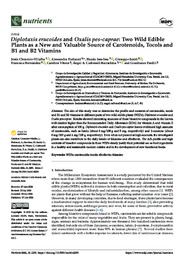Por favor, use este identificador para citar o enlazar este ítem:
https://hdl.handle.net/11000/35053Registro completo de metadatos
| Campo DC | Valor | Lengua/Idioma |
|---|---|---|
| dc.contributor.author | Clemente Villalba, Jesús | - |
| dc.contributor.author | Fratianni, Alessandra | - |
| dc.contributor.author | Ianiri, Giuseppe | - |
| dc.contributor.author | Hernández, Francisca | - |
| dc.contributor.author | Vitone, Caroline | - |
| dc.contributor.author | Carbonell-Barrachina, Ángel A. | - |
| dc.contributor.author | Panfili, Gianfranco | - |
| dc.contributor.other | Departamentos de la UMH::Producción Vegetal y Microbiología | es_ES |
| dc.date.accessioned | 2025-01-20T19:00:24Z | - |
| dc.date.available | 2025-01-20T19:00:24Z | - |
| dc.date.created | 2024-07-17 | - |
| dc.identifier.citation | Nutrients 2024, 16(14), 2293 | es_ES |
| dc.identifier.issn | 2072-6643 | - |
| dc.identifier.uri | https://hdl.handle.net/11000/35053 | - |
| dc.description.abstract | The aim of this study was to determine the profile and contents of carotenoids, tocols and B1 and B2 vitamins in different parts of two wild edible plants (WEPs), Diplotaxis erucoides and Oxalis pes-caprae. Results showed interesting amounts of these bioactive compounds in the leaves, with intakes higher than the Recommended Daily Allowance (RDA) for vitamin A and vitamin E after consumption of 100 g. Diplotaxis erucoides and Oxalis pes-caprae leaves evidenced high amounts of carotenoids, such as lutein (about 8 mg/100 g and 5 mg, respectively) and β-carotene (about 8 mg/100 g and 4 mg/100 g, respectively). Even when not present at high amounts, the investigated plants can also contribute to the daily intake of thiamine and riboflavin. The rich profile and high contents of bioactive compounds in these WEPs clearly justify their potential use as food ingredients in a healthy and sustainable modern cuisine and in the development of new functional foods | es_ES |
| dc.format | application/pdf | es_ES |
| dc.format.extent | 11 | es_ES |
| dc.language.iso | eng | es_ES |
| dc.publisher | MDPI | es_ES |
| dc.rights | info:eu-repo/semantics/openAccess | es_ES |
| dc.rights | Attribution-NonCommercial-NoDerivatives 4.0 Internacional | * |
| dc.rights.uri | http://creativecommons.org/licenses/by-nc-nd/4.0/ | * |
| dc.subject | WEPs | es_ES |
| dc.subject | Carotenoids | es_ES |
| dc.subject | Tocols | es_ES |
| dc.subject | Riboflavin | es_ES |
| dc.subject | Thiamine | es_ES |
| dc.title | Diplotaxis erucoides and Oxalis pes-caprae: Two Wild Edible Plants as a New and Valuable Source of Carotenoids, Tocols and B1 and B2 Vitamins | es_ES |
| dc.type | info:eu-repo/semantics/article | es_ES |
| dc.relation.publisherversion | https://doi.org/10.3390/nu16142293 | es_ES |

Ver/Abrir:
Diplotaxis erucoides and Oxalis pes-caprae.pdf
902,54 kB
Adobe PDF
Compartir:
 La licencia se describe como: Atribución-NonComercial-NoDerivada 4.0 Internacional.
La licencia se describe como: Atribución-NonComercial-NoDerivada 4.0 Internacional.
.png)